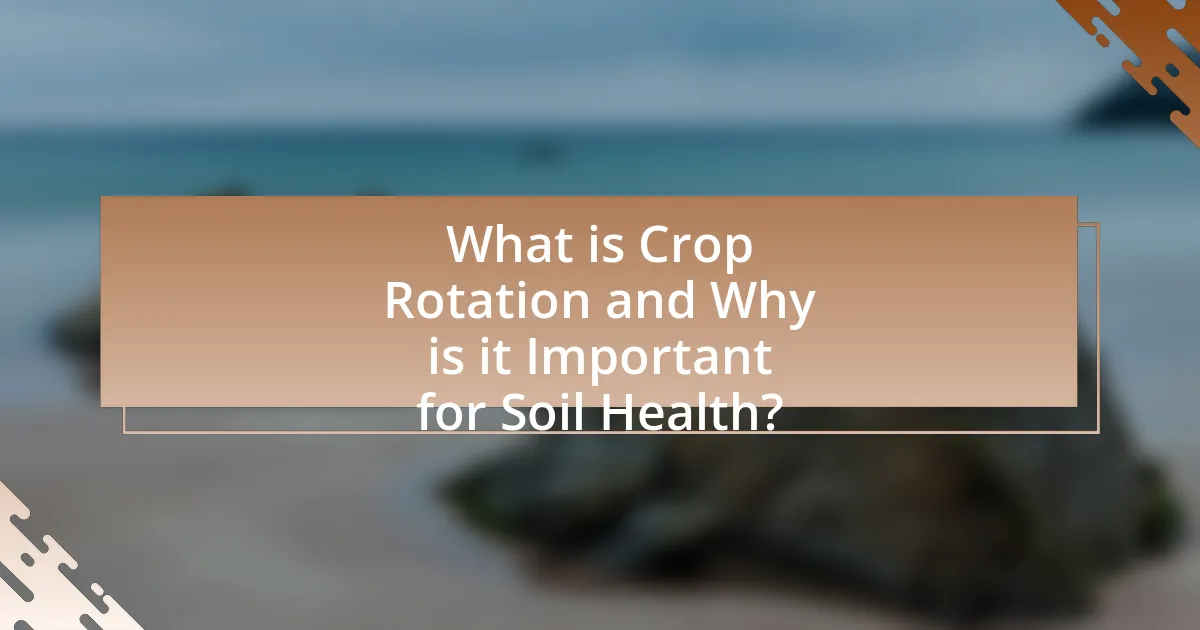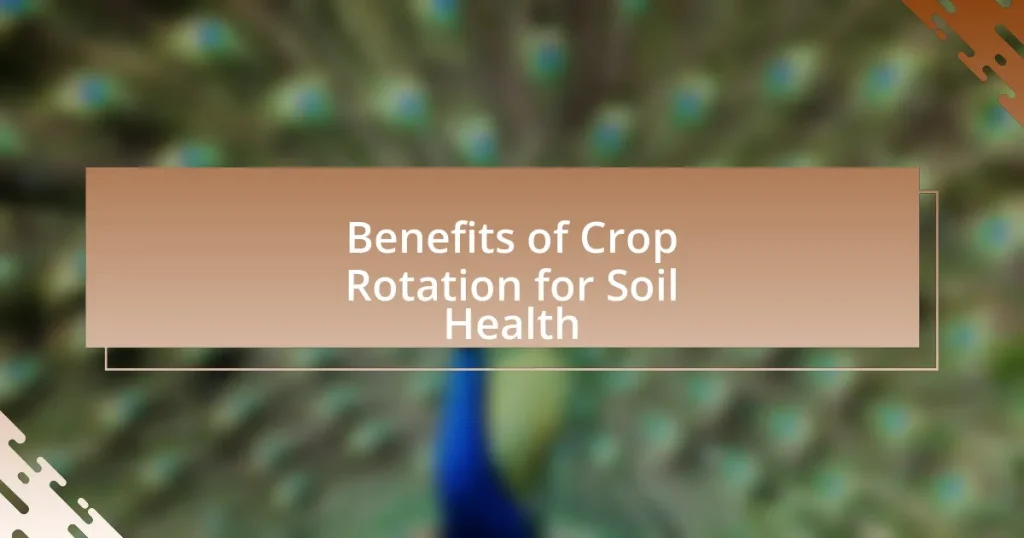Crop rotation is an agricultural practice that involves alternating different types of crops in a specific area over time, significantly contributing to soil health. This method enhances soil fertility, reduces erosion, and disrupts pest and disease cycles, leading to improved crop yields and sustainable farming practices. Key principles of crop rotation include varying nutrient requirements and root structures of different crops, which help maintain a balanced nutrient profile and promote biodiversity. Additionally, crop rotation plays a vital role in pest management and nutrient replenishment, with legumes being particularly effective in fixing nitrogen in the soil. Overall, implementing crop rotation can lead to healthier soil, increased organic matter, and better water retention, ultimately benefiting agricultural productivity and environmental sustainability.

What is Crop Rotation and Why is it Important for Soil Health?
Crop rotation is the agricultural practice of alternating the types of crops grown in a specific area across seasons or years. This method is important for soil health because it enhances soil fertility, reduces soil erosion, and disrupts pest and disease cycles. For instance, rotating legumes with cereals can increase nitrogen levels in the soil, improving overall soil quality. Research indicates that crop rotation can lead to a 20-30% increase in crop yields compared to continuous cropping systems, demonstrating its effectiveness in maintaining sustainable agricultural practices.
How does crop rotation contribute to soil health?
Crop rotation enhances soil health by improving nutrient availability, reducing soil erosion, and promoting biodiversity. Different crops have varying nutrient requirements and root structures, which helps maintain a balanced nutrient profile in the soil. For instance, legumes, such as beans and peas, fix nitrogen in the soil, enriching it for subsequent crops. Additionally, rotating crops minimizes the risk of soil degradation and pest infestations, as diverse plant species disrupt the life cycles of pests and diseases. Research indicates that fields with diverse crop rotations show increased organic matter and microbial activity, which are critical indicators of healthy soil.
What are the key principles of crop rotation?
The key principles of crop rotation include alternating different types of crops in a specific sequence to improve soil health, manage pests and diseases, and enhance nutrient availability. This practice helps prevent soil depletion by ensuring that various crops utilize different nutrients and contribute organic matter to the soil. For instance, legumes can fix nitrogen in the soil, benefiting subsequent crops. Research indicates that crop rotation can increase yields by up to 20% compared to continuous cropping systems, demonstrating its effectiveness in promoting sustainable agriculture and soil vitality.
How does crop rotation affect soil structure?
Crop rotation improves soil structure by enhancing soil aggregation and reducing compaction. Different crops contribute varying root structures and organic matter, which promote the formation of stable soil aggregates. For instance, deep-rooted crops like alfalfa can break up compacted layers, while cover crops add organic matter that improves soil porosity and aeration. Research indicates that fields with diverse crop rotations exhibit better soil structure compared to monoculture systems, leading to increased water infiltration and reduced erosion. This is supported by studies showing that crop rotation can increase soil organic carbon levels, which is crucial for maintaining healthy soil structure.
What are the environmental benefits of crop rotation?
Crop rotation provides significant environmental benefits by enhancing soil health, reducing erosion, and improving biodiversity. By alternating different crops, soil nutrients are replenished, which minimizes the need for chemical fertilizers. For instance, legumes in crop rotation can fix nitrogen in the soil, promoting nutrient cycling. Additionally, crop rotation helps break pest and disease cycles, reducing reliance on pesticides and fostering a more balanced ecosystem. Research indicates that fields with diverse crop rotations can increase organic matter and improve soil structure, leading to better water retention and reduced runoff, which ultimately protects water quality.
How does crop rotation enhance biodiversity in soil?
Crop rotation enhances biodiversity in soil by promoting a diverse range of plant species, which in turn supports various soil organisms. This practice reduces the dominance of specific crops that can deplete certain nutrients and disrupt microbial communities. For instance, rotating legumes with cereals can increase nitrogen levels in the soil, benefiting both the plants and the microorganisms that thrive in such environments. Studies have shown that diverse cropping systems can lead to higher populations of beneficial organisms, such as earthworms and mycorrhizal fungi, which are crucial for nutrient cycling and soil structure.
What role does crop rotation play in pest and disease management?
Crop rotation plays a crucial role in pest and disease management by disrupting the life cycles of pests and pathogens. By alternating different crops in a specific sequence, farmers can reduce the prevalence of crop-specific pests and diseases that thrive in monoculture systems. For instance, rotating crops such as legumes with cereals can lower the population of root-feeding nematodes and other soil-borne pathogens, as these organisms often have specific host plants. Research has shown that implementing crop rotation can lead to a significant decrease in pest populations, with studies indicating up to a 50% reduction in certain pest infestations when diverse crops are used in rotation. This practice not only enhances crop resilience but also promotes overall soil health by improving biodiversity and nutrient cycling.

What specific benefits does crop rotation provide for soil nutrients?
Crop rotation enhances soil nutrients by improving nutrient availability and reducing soil depletion. Different crops have varying nutrient requirements and root structures, which allows for a more balanced nutrient uptake from the soil. For instance, legumes, such as beans and peas, fix atmospheric nitrogen, enriching the soil with this essential nutrient for subsequent crops. Research indicates that crop rotation can increase soil organic matter and microbial activity, further enhancing nutrient cycling and availability. Studies have shown that fields with diverse crop rotations can yield up to 20% more than those with continuous cropping, demonstrating the effectiveness of this practice in maintaining soil fertility.
How does crop rotation improve nutrient availability in the soil?
Crop rotation improves nutrient availability in the soil by alternating different types of crops, which enhances soil fertility and structure. This practice allows for the replenishment of essential nutrients, as different crops have varying nutrient requirements and contributions. For instance, legumes, such as beans and peas, fix atmospheric nitrogen into the soil, enriching it for subsequent crops that require nitrogen. Additionally, rotating crops can disrupt pest and disease cycles, reducing the need for chemical fertilizers and promoting a healthier soil ecosystem. Studies have shown that fields with diverse crop rotations can yield higher overall nutrient levels compared to monoculture systems, demonstrating the effectiveness of this agricultural practice in maintaining soil health.
What crops are best for replenishing specific nutrients?
Leguminous crops, such as clover and beans, are best for replenishing nitrogen in the soil. These crops have the ability to fix atmospheric nitrogen through symbiotic relationships with bacteria in their root nodules, enriching the soil with this essential nutrient. Additionally, deep-rooted crops like alfalfa can improve soil structure and bring up nutrients from deeper soil layers, while brassicas, such as mustard, can help in replenishing sulfur. Research indicates that incorporating these crops into crop rotation systems enhances soil fertility and overall health, supporting sustainable agricultural practices.
How does crop rotation prevent nutrient depletion?
Crop rotation prevents nutrient depletion by alternating the types of crops grown in a specific area, which helps maintain soil fertility. Different crops have varying nutrient requirements and uptake patterns; for example, legumes can fix nitrogen in the soil, replenishing this essential nutrient that other crops may deplete. Research indicates that rotating crops can lead to improved soil structure and increased organic matter, which further enhances nutrient availability. Studies show that farms practicing crop rotation can yield 10-20% more than those using monoculture, demonstrating the effectiveness of this practice in sustaining soil health and preventing nutrient loss.
What impact does crop rotation have on soil erosion?
Crop rotation significantly reduces soil erosion by enhancing soil structure and promoting biodiversity. When different crops are planted in succession, their varying root systems help to stabilize the soil, preventing it from being washed or blown away. Research indicates that fields with diverse crop rotations experience up to 50% less soil erosion compared to monoculture systems. Additionally, crop rotation improves organic matter content, which further enhances soil cohesion and reduces erosion risk.
How does crop rotation help in maintaining soil cover?
Crop rotation helps in maintaining soil cover by promoting diverse plant growth, which reduces soil erosion and enhances soil structure. Different crops have varying root systems and growth patterns, allowing for better soil stabilization and coverage throughout the year. For instance, deep-rooted plants can penetrate compacted soil layers, improving aeration and water infiltration, while cover crops like clover or rye can protect the soil surface from erosion during off-seasons. Research indicates that fields with diverse crop rotations experience up to 30% less soil erosion compared to monoculture systems, demonstrating the effectiveness of crop rotation in preserving soil integrity and health.
What practices can be combined with crop rotation to reduce erosion?
Cover crops can be combined with crop rotation to effectively reduce erosion. Cover crops, such as clover or rye, provide ground cover that protects the soil from wind and water erosion, while also improving soil structure and fertility. Research indicates that fields with cover crops experience significantly less soil erosion compared to those without, as they enhance soil stability and moisture retention. Additionally, practices like contour farming and no-till farming can further complement crop rotation by maintaining soil integrity and reducing runoff, thereby contributing to overall soil health.

How can farmers effectively implement crop rotation?
Farmers can effectively implement crop rotation by planning a systematic sequence of different crops over several growing seasons to enhance soil health and reduce pest and disease pressure. This practice involves selecting crops that have varying nutrient requirements and growth habits, which helps maintain soil fertility and structure. For instance, rotating legumes with cereals can improve nitrogen levels in the soil, as legumes fix atmospheric nitrogen. Research indicates that crop rotation can lead to a 10-20% increase in crop yields and a significant reduction in soil erosion, as demonstrated in studies by the USDA Agricultural Research Service.
What are the best practices for planning a crop rotation schedule?
The best practices for planning a crop rotation schedule include selecting diverse crops, considering nutrient needs, and timing planting and harvesting effectively. Diverse crops help break pest and disease cycles, while rotating crops with different nutrient requirements can enhance soil fertility. For instance, legumes can fix nitrogen in the soil, benefiting subsequent crops. Additionally, planning the timing of planting and harvesting ensures that soil is covered throughout the year, reducing erosion and improving soil structure. Research indicates that implementing these practices can lead to improved soil health and increased crop yields over time.
How can farmers assess their soil health before implementing crop rotation?
Farmers can assess their soil health before implementing crop rotation by conducting soil tests to evaluate nutrient levels, pH, organic matter content, and microbial activity. Soil testing provides quantitative data that indicates the soil’s fertility and overall health, which is essential for determining the appropriate crop rotation strategy. Research shows that soil tests can reveal deficiencies or imbalances in essential nutrients, such as nitrogen, phosphorus, and potassium, which can impact crop yields. Additionally, assessing soil structure and compaction through physical examination helps farmers understand water retention and root penetration capabilities, further informing their crop rotation decisions.
What common mistakes should be avoided in crop rotation?
Common mistakes to avoid in crop rotation include failing to diversify crops, which can lead to pest and disease buildup, and not considering soil nutrient needs, resulting in nutrient depletion. Additionally, neglecting to plan for crop sequences can disrupt beneficial relationships between plants, while rotating crops too frequently or not frequently enough can hinder soil health. Research indicates that diverse crop rotations can improve soil structure and fertility, as shown in studies by the USDA, which highlight the importance of varied plant families to break pest cycles and enhance soil microbial diversity.
What resources are available for farmers interested in crop rotation?
Farmers interested in crop rotation can access a variety of resources including agricultural extension services, university research publications, and online platforms dedicated to sustainable farming practices. Agricultural extension services provide localized advice and support, often offering workshops and materials on crop rotation techniques. University research publications, such as those from land-grant universities, present scientific studies and guidelines that detail the benefits and methods of crop rotation. Online platforms like the Sustainable Agriculture Research and Education (SARE) program offer comprehensive resources, including case studies and best practices, to help farmers implement effective crop rotation strategies. These resources collectively support farmers in enhancing soil health and improving crop yields through informed crop rotation practices.
How can agricultural extension services assist in crop rotation planning?
Agricultural extension services can assist in crop rotation planning by providing farmers with research-based information and tailored recommendations on crop selection and sequencing. These services analyze local soil conditions, climate, and pest pressures to suggest optimal crop combinations that enhance soil health and productivity. For instance, studies have shown that rotating legumes with cereals can improve nitrogen levels in the soil, thereby reducing the need for synthetic fertilizers. Additionally, extension services often conduct workshops and field demonstrations to educate farmers on the benefits of crop rotation, leading to improved soil structure and reduced erosion.
What online tools and resources can help in crop rotation management?
Online tools and resources that assist in crop rotation management include Crop Rotation Planner, AgriWebb, and the USDA’s Crop Rotation Guide. Crop Rotation Planner allows farmers to design and visualize crop rotation schedules tailored to their specific fields, enhancing soil health and productivity. AgriWebb offers a farm management platform that includes features for tracking crop rotations and analyzing soil health data. The USDA’s Crop Rotation Guide provides research-based recommendations and best practices for effective crop rotation, emphasizing its benefits for soil health, such as improved nutrient cycling and reduced pest pressure. These resources collectively support farmers in implementing effective crop rotation strategies that promote sustainable agriculture.
What are the practical steps to start crop rotation on a farm?
To start crop rotation on a farm, first, assess the current soil health and crop history to determine which crops have been grown previously. Next, develop a rotation plan that includes a diverse selection of crops, such as legumes, grains, and vegetables, to enhance soil nutrients and reduce pest cycles. Implement the rotation by planting the selected crops in designated fields according to the plan, ensuring that each crop is rotated to a different area each season. Finally, monitor soil health and crop performance regularly to adjust the rotation plan as needed for optimal results. This method is supported by research indicating that crop rotation can improve soil structure and fertility, leading to healthier crops and reduced reliance on chemical fertilizers.










